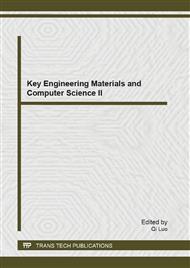[1]
Zhang Tao. DCT Domain binary image watermarking algorithm based on Chaos and scrambling encryption [D]. Harbin: Harbin Polytechnic University (master's degree thesis), 2008.
Google Scholar
[2]
Ge Qingbing, Li Kairong. Research on image fusion method based on wavelet analysis [J]. Huaihai Institute of Technology (Natural Science) 2010 (02)
Google Scholar
[3]
Sun Yan, Zhao Chunhui, Chen Liwei. Multiscale image fusion methods based on wavelet domain [J]. Applied Science and Technology (10)
Google Scholar
[4]
Liu Jing, Tang Guoyu. Image fusion method and its performance evaluation based on wavelet transform [J]. Enterprise technology and development 2011 (13)
Google Scholar
[5]
You Liping, FangYing. Research on multifocus image algorithm based on wavelet transforms [J]. Electromechanical technology. 2011 (03)
Google Scholar
[6]
Chu Binbin, Pang Lulu, Qi Dening, Wang Tan, Chen Yong. Review of image fusion technology based on multi-scale analysis [J]. Avionics technology. 2009 (03)
Google Scholar
[7]
Guo Lei, Cheng Gong, Zhao Tianyun. Multi-focus image fusion algorithm based on wavelet transform and neighborhood characteristics [J]. Northwestern Polytechnic University 2011 (03)
Google Scholar
[8]
Ge Wen, Li Na, Zhao Rui. Fast image fusion algorithm based on wavelet lifting mechanism [J] Science and Technology and Engineering, 2008 (08).
Google Scholar
[9]
Xu Li Qun, Ye Xi, Xu Shancai, Yu Feihong. A quick and simple multifocal plane microscopy image fusion method [J] Optical instruments. 2007(05)
Google Scholar
[10]
MALLAT S G.A Theory for multiresolution signal decomposition:the wavelet representation. IEEE Trans-actions on Pattern Analysis and Machine Intelligence . (1989)
DOI: 10.1109/34.192463
Google Scholar
[11]
JIANG J M,FENG G C.The spatial relationship of DCT coefficients between a block and its sub-blocks. IEEE Transactions on Electromagnetic Compatibility . (2002)
DOI: 10.1109/78.995072
Google Scholar
[12]
PAJARES G,CRUZ J M.A wavelet-based image fusion tutorial. Pattern Recognition . (2004)
Google Scholar
[13]
LI H,MANJUNATH B S,MITRA S K.Multisensor image fusion using the wavelet transform. GraphicalModels and Image Processing . (1995)
DOI: 10.1006/gmip.1995.1022
Google Scholar
[14]
ZHANG ZH,BLUM R S.A Categorization of multiscale-decomposition-based image fusion schemes with a per-formance study for a digital camera application. Proceedings of Tricomm . (1999)
DOI: 10.1109/5.775414
Google Scholar


